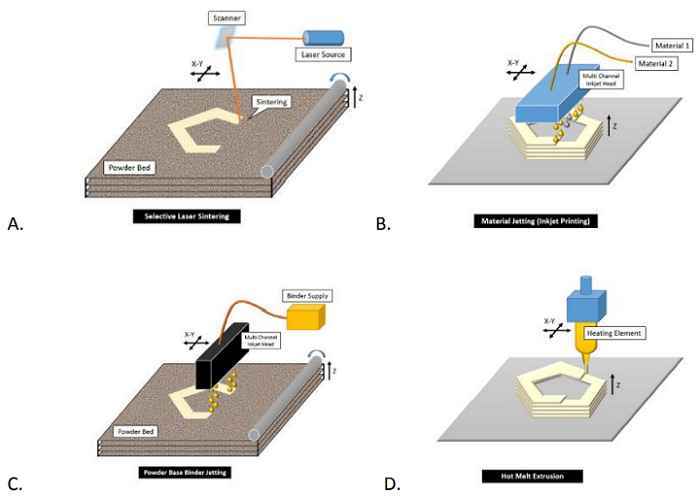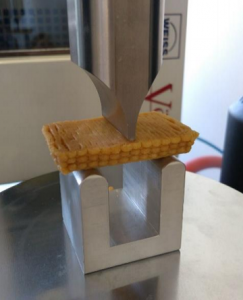While it may sound great to sit around and eat cookies all day, the fact is that cookies aren’t particularly healthy because they’re chock full of sugar. But, partially because obesity rates have been increasing over the last few decades, people have been more focused on reducing sugar in tasty foods like cookies, or replacing it with something else altogether, like artificial sweeteners such as sucrose. But another trend has also emerged: that of ‘clean label products’ with few or no additives. Desserts could appeal to both trends if a product’s sweetness is increased in a different way, while its overall sucrose is reduced.

Types of 3D food printing: A) Selective laser sintering, B) Inkjet printing, C) Binder jetting, D) Extrusion-based printing
A fairly new way to prepare sweet treats like cookies is 3D printing. The technology makes it possible to create complex, reproducible 3D structures impossible to make by hand alone, and can also help with more customized nutritional requirements.
Tim Meuleman, a student at Wageningen University & Research in the Netherlands, recently wrote a thesis paper, titled “Sugar reduction in cookies by using 3D food printing,” on using 3D printing to achieve sugar reduction in cookies.
The abstract reads, “3D food printing was used to prepare cookies containing different sugar replacers, and cookies containing different doughs which were layered. The effect of these preparation methods on cookie quality properties was investigated. By doing this it could be observed if 3D food printing could be used for achieving sugar reduction in cookies. The cookies were prepared by 3D food printing a dough, which contained sucrose or a sugar replacer. Correlations between the molecular weight of the sugar replacer used and physicochemical properties like texture, water activity, dry matter content, shape stability and bake stability were investigated. Furthermore, the influence of 3D printing on these properties, and the influence of layering different doughs on these properties was investigated. Also, a sensory analysis was performed, to determine the influence of the layering of doughs on perceived sweetness. The effect of molecular weight was tested for homogeneous cookies containing one of the following sugar (replacers); sucrose, xylitol, maltitol, oligofructose and polydextrose. The conclusion was that the inhomogeneous distribution of sucrose in a sugar reduced cookie by layering with a 3D printer does increase the perceived sweetness in comparison to a sugar reduces cookie where the sucrose is homogeneously distributed. The sugar replacement as well as the printing did have influence on the measured physicochemical properties, however these were only small differences. The layering does have influences on the bake stability and fracture stress, however also only small differences were observed.”
The goal of Meuleman’s thesis was to investigate the effect of different sugar replacements in cookie dough, along with the structuring of the cookies based on properties such as shape stability, taste, and texture.
“3D printing was first used to print doughs containing sugar a single sugar replacer to evaluate the impact of the sugar replacement on 3D printing, on physicochemical attributes like final cookie texture, water activity, dry matter content and shape stability. Different doughs were prepared to find the right recipe suitable for 3D printing,” Meuleman wrote. “Next, it was investigated if printing of different layered structures with alternatively the sucrose containing dough and the dough with a sugar replacer improves the texture and/or taste of the cookies in comparison to cookies with homogeneously distributed sucrose and sugar replacers. The influence of the layering and composition of the layered structure on the final cookie properties were especially examined. Furthermore the effect of printing on the cookies was examined by comparing printed cookies to cookies where the dough was cut to shape in the same dimensions as the printed cookies.”
Meuleman used an adapted version of a recipe for a 3D printable dough that he wrote had been “found by unpublished internal experiments at TNO (The Hague, the Netherlands), acquired via Stefano Renzetti,” and chose the various sugar replacers because of the variations between their molecular weight; this allowed him to observe how cookie properties, like dry matter content and texture, were influenced.
Once cookie dough was prepared with a variety of sugar replacers, Meuleman created a design for 3D printing a rectangular cookie in OpenSCAD, which was then loaded into Slic3r before being fabricated on a byFlow 3D food printer.
After the cookies were baked, they were packaged in aluminum foil to sit for a day, so the water could redistribute inside before the dry matter content and water activity were measured and the texture analysis was performed.
“The texture of the cookie was determined by a three-point bending test to investigate the influence of the recipe and the structure design on texture. The printability was assessed visually, by determining if the printed structure has the same dimensions, if it resembled the created design and if the dough caused any errors during printing. The stability was assessed by making measurements of the dimensions of the cookie before and after baking. Finally, the taste was evaluated by sensory test,” Meuleman wrote.
 He concluded that 3D printing was a good way to lower the sugar content in cookies, because it does not negatively influence the texture and also increases the perceived sweetness without having to add any artificial sweeteners.
He concluded that 3D printing was a good way to lower the sugar content in cookies, because it does not negatively influence the texture and also increases the perceived sweetness without having to add any artificial sweeteners.
Future research could focus on developing dough that is easier to 3D print.
“Other interesting effects that could be investigated are: researching other influences from changing the sugar replacer than the changing the molecular weight of the sugar or sugar replacers, like water binding capacity,” Meuleman concluded. “These influences could also be applied to the data collected in this thesis.”
Discuss this story and other 3D printing topics at 3DPrintBoard.com or share your thoughts in the comments below.
Subscribe to Our Email Newsletter
Stay up-to-date on all the latest news from the 3D printing industry and receive information and offers from third party vendors.
You May Also Like
Precision at the Microscale: UK Researchers Advance Medical Devices with BMF’s 3D Printing Tech
University of Nottingham researchers are using Boston Micro Fabrication‘s (BMF) 3D printing technology to develop medical devices that improve compatibility with human tissue. Funded by a UK grant, this project...
3D Printing Webinar and Event Roundup: April 21, 2024
It’s another busy week of webinars and events, starting with Hannover Messe in Germany and continuing with Metalcasting Congress, Chinaplas, TechBlick’s Innovation Festival, and more. Stratasys continues its advanced training...
3D Printing Webinar and Event Roundup: March 17, 2024
It’s another busy week of webinars and events, including SALMED 2024 and AM Forum in Berlin. Stratasys continues its in-person training and is offering two webinars, ASTM is holding a...
3D Printed Micro Antenna is 15% Smaller and 6X Lighter
Horizon Microtechnologies has achieved success in creating a high-frequency D-Band horn antenna through micro 3D printing. However, this achievement did not rely solely on 3D printing; it involved a combination...































